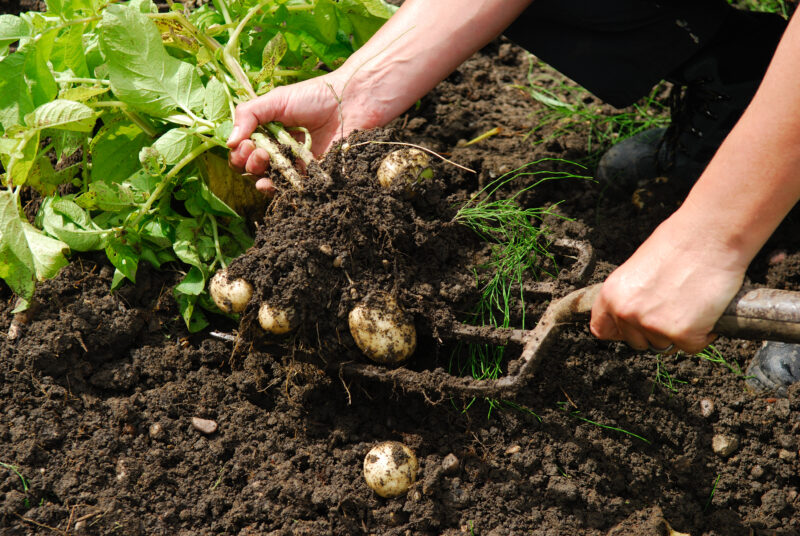Over the years, I’ve often found myself wondering what I need to plant, when I need to plant it and how much space I need to plant it in to be able to feed my family without ever going to the store.
I’ve read all sorts of books to try and give me an edge, from square foot gardening to vertical gardening and both have increased my yields – along with no dig gardening and perennial fruit tree planting – but the reality is: food takes space to grow.
So what I’ve arrived at over the last decade is a combination of well planned out crops in my own greenhouse, fruit trees around my property border, 4 chickens for eggs and a secret journal of where to find food in the wild to help with my self sufficient gardening efforts.
The importance of that last component shouldn’t be understated.
I’ve written about how to forage for food in a city, how to keep chickens in a city and how to find apple trees growing in the wild in other food self sufficiency guides but for this one, I’m going to focus on what crops to plant, when to plant them and how much space you need to grow your own self sufficient garden in your own backyard.
It’s taken me a while to put it together and the information will need to be adjusted to suit your own climate. I’m in a temperate climate so the timeframes work for me here in the northern part of the UK.
I hope you find it useful!

With this guide, I’m approaching the topic of self sufficient gardening from the context of a family of 4; 2 adults and 2 children.
The target yields I’m aiming for are appropriate for this size family. You’ll have to adjust to suit your own situation.
The purpose of what I’m trying to achieve is to grow densely nutritious fruits and vegetables that:
- Provide valuable nutrition relative to the space they need to grow
- Store throughout the winter
I don’t have a lot of space by many standards, but it’s more than most, and I do what I can with what I’ve got and make up the shortfall by foraging, hunting and buying in bulk.
I have a 45sqm (approx. 460sqft) greenhouse with 4 raised beds and a total growing area of 170sqft. It’s not as efficient as I’d like it to be in terms of space – yet!
In addition to my greenhouse, I also have fruit trees around the border and about 100sqft for pots.
I’m not able to grow everything we need to keep us fed but I have made a record each year of how much space I’d need and what I’d need to plant to make it possible.
You will be able to use this record to work out what you can do in your own garden to become more self sufficient.
The Essential Components of Successful Self Sufficient Gardening
There are a few essential considerations to take into account before you begin:
- Choose crops suited to your climate and soil conditions
- Learn about succession planting
- Work with the seasons, not against them
- You need time to be able to tend to your garden
I’ll offer a few pointers from experience on each of the above before presenting you with my self sufficient gardening planting guide for temperate climates.
Choose Crops Suited To Your Climate & Soil Conditions
This is so important. For the best chance of a successful harvest, you should only work with crops that grow well in your area. The more acclimatised to your area, the better.
Before you grow, you should make an effort to get hold of seeds from local growers or local suppliers/plant nurseries that have demonstrable experience with growing that particular crop in your area.
If you do this, it will shave years off your learning.
I live in the North of England, which is considered a temperate climate, so I stick to what I know grows here. Crops like kale, broccoli, and cabbage.
If you live in a warmer climate, you may want to specialise in crops such as peppers, tomatoes, or sweet potatoes.
Always seek out your best and nearest gardening friend for advice before you begin – they will improve your yield more than any book ever could!
Learn About Succession Planting

Succession planting is the process of staggering out your planting times by several weeks so that you don’t get a glut of the same crop all at once but, rather, get them spread over the season, as and when you need them.
Of all the self sufficient gardening skills to master, succession planting is the highest priority.
Master this, and you will be amazed at what you can achieve. As an example, you could plant a new batch of beans every few weeks or plant a new row of carrots every few weeks.
Try it with fast growing crops to get a feel for how demanding and time consuming it can be if not planned properly.
Succession planting is essential for salad greens in the summer as they tend to ‘bolt’ (flower and go to seed – making the leaf turn bitter) in the heat.
Work With The Seasons, Not Against Them

As a reader of Taoism, I’m a big believer in moving with the rhythm of the world.
Trying to plant against nature is difficult, expensive and just not the way of things. Everything in this realm has a cycle for a reason, even you, and to ignore it or try to circumvent it is asking for trouble.
That’s not to say that I don’t appreciate the ingenuity and creativity of hydroponics, aquaponics or aeroponics under LED lighting, but I do recognise that these out of season operations require external inputs in the form of energy and that is something I try to avoid wherever possible.
Summarising then, working with the seasons means planting your crops in harmony with them and even working with the cycles of the moon. There is ancient, primordial energy there that should be harnessed and not ignored.
Sometimes it feels like our technology has allowed us to forget the basics and in their absence, we have become sleeping dependants on a mechanical system that we have no true control over.
This doesn’t seem very wise…
Time To Tend Your Garden
When I started growing my own food about 10 years ago, I had no idea how much of my time it would take.
Prior to that, I had always held this romantic fantasy of owning an allotment ‘just round the corner’, but in building raised beds in my own garden, I have learnt that it is far easier to tend a productive garden if it is very close to where you are.
In permaculture, I believe they call this ‘zoning’; where the things you need to tend to the most often are planted closest to your centre of activity and the things you need to tend to less get planted further and further away.
It makes perfect sense, and only in the act of doing my own self sufficient gardening did I learn how important this was.
The kinds of things you’ll need to do daily are:
- Watering
- Weeding
- Fertilising
- Monitoring for pests and diseases
At the very minimum, you should plan to set aside a couple of hours a day to do all the things that need doing.
On the plus side, if you can do all of that, nature will repay you with abundance.
A Self Sufficient Gardening Planting Guide For Temperate Climates
The table below contains all the information I’ve recorded over a decade of growing and researching how to become more self sufficient with my own garden.
Feel free to copy and paste and add your own experience for your own climate or you can download the self sufficient gardening spreadsheet planting guide here.
| Crop | Planting Time | Spacing | Yield Per Plant | Harvest Time | Days To Maturity | # of Plants Per Family | Total Space Required |
|---|---|---|---|---|---|---|---|
| Potatoes | March-April | 12-15″ apart | 5-10 lbs | July-September | 90-120 days | 100-150 | 150 sq. ft. |
| Winter Squash | May-June | 3-4′ apart | 5-10 lbs | August-October | 80-120 days | 10-20 | 100 sq. ft. |
| Pumpkins | May-June | 3-4′ apart | 10-20 lbs | September-November | 90-120 days | 6-12 | 100 sq. ft. |
| Beans (pole) | May-June | 4-6″ apart | 2-4 lbs | July-September | 60-90 days | 30-40 | 60 sq. ft. |
| Corn | May-June | 12″ apart | 1-2 ears | August-September | 70-100 days | 60 | 60 sq. ft. |
| Winter Greens (kale, spinach, lettuce) | August-September | 6-8″ apart | 1-2 lbs | October-March | 45-90 days | 50 | 40 sq. ft. |
| Carrots | March-April, August | 2-3″ apart | 1-2 lbs | May-November | 70-80 days | 100 | 40 sq. ft. |
| Tomatoes | May-June | 24-36″ apart | 10-20 lbs | July-September | 70-90 days | 10-15 | 100 sq. ft. |
| Peppers | May-June | 18-24″ apart | 5-10 lbs | July-September | 70-90 days | 10-15 | 60 sq. ft. |
| Onions | March-April | 4-6″ apart | 1-2 lbs | July-September | 90-120 days | 100 | 40 sq. ft. |
| Cabbage | March-April, August | 12-18″ apart | 3-6 lbs | May-September | 60-100 days | 20 | 60 sq. ft. |
How Much Space Do You Need To Plant A Self Sufficient Garden?
If you take a moment to look through the planting guide above you’ll notice the end column provides a rough estimate of the total space in sqft you’d need to grow the quantity of that crop required to feed a family of 4.
If you grew everything in the list, you’d need 800 – 900sqft of growing space or 75 to 85sqm.
An Ancient Native Indian Technique To Maximise Your Growing Space

It is said that over a thousand years ago, indigenous Indian tribes developed the three sisters method of agriculture.
The three sisters method is a way to grow corn, beans and squash together on the same piece of land.
I use this method every other season in rotation so as not to deplete my soil of the same minerals year after year.
The biggest advantage of the three sisters is that you can increase your yield because the 3 crops grow together. It is even said they compliment one another.
In my example, I am able to use half of my greenhouse growing (about 85sqft) space to grow 200sqft of vegetables.
Make Up The Shortfall By Hunting, Foraging & Buying in Bulk

If, like me, you don’t have 900 sqft for growing your own self sufficient garden in your backyard, you can make up the shortfall by hunting ‘pests’, like rabbits, foraging, or, the simple option, buying in bulk.
I experienced a huge shift in mindset once I expanded my ‘self sufficiency’ ideals to include foraging. Once you learn how to go out into the wild and eat what you find, becoming self sufficient doesn’t seem so far fetched an idea after all.
If you’d like to learn more about wild foraging, I reviewed Mo Wilde’s book The Wilderness Cure here and in that book, she takes you through an entire year of foraging wild food which acts like a foraging guide for the uninitiated.
Final Thoughts: Self Sufficient Gardening For A Family of 4
Self sufficient gardening for a family of 4 is possible, but you need about 900 sqft of space and at least 2 hours a day to tend the garden.
If you can’t find a way to make these things happen, you’re going to have to combine what you can manage with a way to pick up the shortfall. A couple of things you could explore:
- You could form a local growing group with other likeminded friends to each make an effort to grow one particular crop that can be shared with the entire group.
- You could ask friends or relatives who have no interest in using their garden or are too old to tend it if you can use their gardens to make up your shortfall in space.
There are many more.
Hopefully though, this guide has presented you with an ideal scenario, a list of preferred crops for my climate and given you an idea of how much space you’ll need to become self sufficient in gardening.
I hope it inspires you to try, even if just one crop, to experience the joy and self-fulfillment, not to mention the empowerment, that you experience by growing your own food.
It is possible. Everything is possible. But first you have to believe it, and second, you have to roll up your sleeves and do it!













